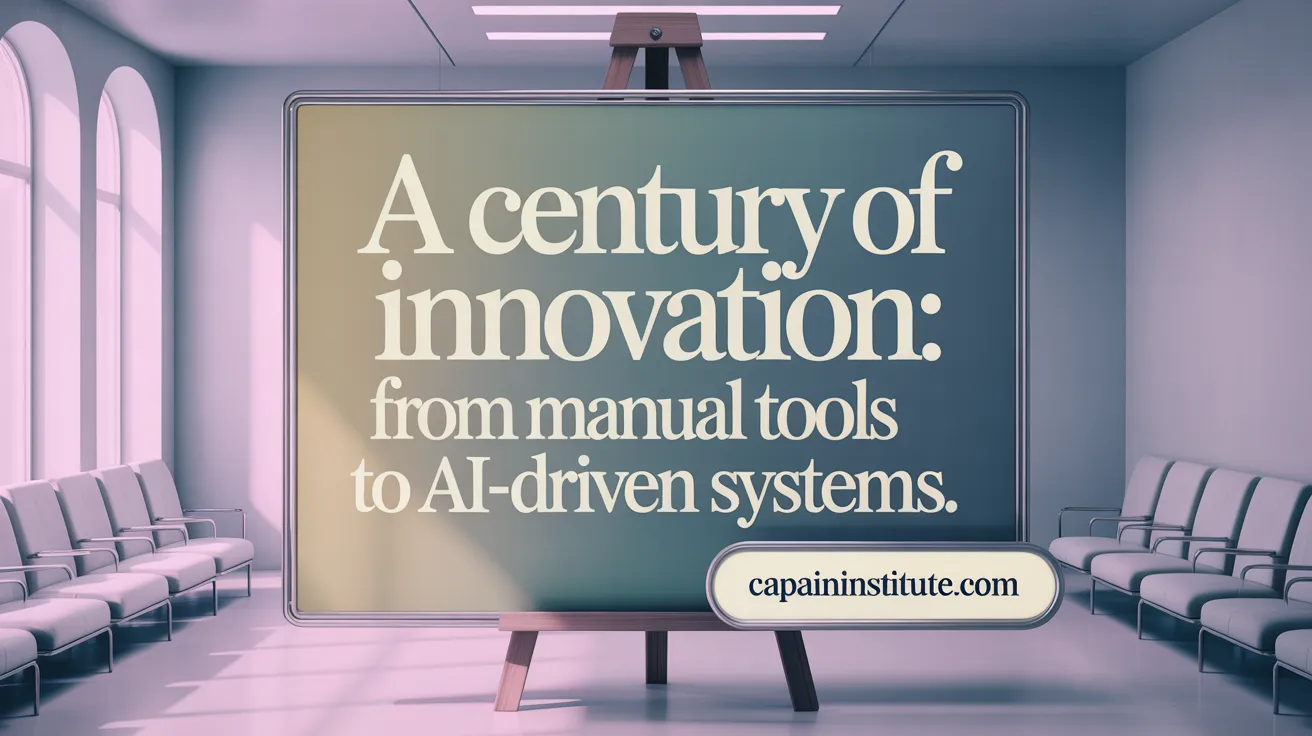Introduction to Innovations in Anesthesiology and Pain Treatment
Historical Evolution of Anesthesiology Technology
Anesthesiology has witnessed profound technological advancements over the past century, beginning with foundational tools such as endotracheal tubes and sphygmomanometers in the early 1900s. The mid-20th century introduced electrical monitoring, including continuous ECG and EEG, enhancing patient safety and monitoring precision. Subsequently, automated devices like mechanical ventilators and blood pressure monitors transformed care delivery, laying the groundwork for today’s sophisticated anesthetic management.
Significance of Anesthesiology Innovations for Chronic Pain Care
These technological strides extend beyond the operating room into chronic pain management. Advanced physiological monitoring and information management systems enable precise patient assessment and personalized anesthetic plans, critical for complex chronic pain cases. Integration of artificial intelligence and robotic assistance shows promising potential in delivering targeted, efficient anesthesia and pain interventions, minimizing risk and improving outcomes.
Overview of Modern Pain Treatment Challenges
Chronic pain remains a multifaceted challenge, often involving biological, psychological, and social components. Treatment effectiveness can be limited by these complexities, underscoring the importance of a biopsychosocial approach. Innovative therapies, including neuromodulation and minimally invasive procedures, aim to address these factors comprehensively.
Relevance to Los Angeles Pain Management Centers
Los Angeles-area pain clinics such as the California Pain Institute and university-affiliated centers are at the forefront of employing these innovations. They harness advanced anesthesiology technologies alongside multidisciplinary strategies to improve patient care quality. By integrating state-of-the-art treatments and personalized planning, these centers offer hope for better chronic pain management outcomes in the region.
From Basic Tools to AI-Driven Systems: A Century of Progress in Anesthesiology

What are the major technological advances in anesthesiology over the last century?
The past 100 years have witnessed remarkable technological progress in anesthesiology, fundamentally transforming patient care. Early developments in the early 20th century anesthetic tools, such as the introduction of endotracheal tubes development and sphygmomanometers in anesthesia, significantly enhanced patient safety during procedures.
Development of monitoring devices and automation
By the 1940s and 1950s, electrical monitoring technologies like Continuous electrocardiography (ECG) advancements and Electroencephalography (EEG) history emerged, providing continuous physiological data that improved anesthesia management. The mid-20th century ushered in automation with Modern mechanical ventilators and Automated blood pressure monitors, enabling clinicians to maintain more precise control over patient vital signs.
Introduction of AI and machine learning in anesthesia
Modern anesthesiology now incorporates Artificial intelligence in anesthesia and Machine learning for outcome prediction systems. These tools enable Real-time vital sign forecasting, disease phenotyping, and outcome prediction, paving the way for more individualized and responsive anesthesia care. Sophisticated Robotic anesthesia systems, including Robot-assisted intubation technology and Ultrasound-guided nerve blocks, mark movement toward fully automated anesthetic delivery.
Impact on patient safety and treatment precision
Technological advances have dramatically increased the safety and effectiveness of anesthetic care. Detailed arterial waveform analysis techniques such as Pulse pressure variation analysis and Stroke volume variation from arterial waveforms allow for precise evaluation of hemodynamics, while Closed-loop anesthesia delivery systems monitor and adjust anesthetic delivery automatically, minimizing risks and enhancing treatment precision.
Role of electronic health records and anesthesia information systems
The integration of Electronic health records in anesthesia and Anesthesia information management systems has revolutionized perioperative management. These systems support Data-driven perioperative management, enable robust outcome prediction, facilitate large-scale research, and enhance coordination of care, which is particularly valuable in complex medical environments like those in Los Angeles healthcare institutions.
Together, these technological milestones reflect a century-long evolution from simple manual tools to sophisticated AI-driven systems, constantly advancing the safety, efficiency, and quality of anesthesiology and pain management.
Integrating Biopsychosocial Approaches in Complex Chronic Pain Management

Understanding complex chronic pain and its multifactorial nature
Chronic pain affects up to 20% of the population and involves more than just physical symptoms. Complex chronic pain cases often intertwine biological, psychological, and social factors, making treatment challenging (expectations of treatment outcome in complex chronic pain cases).
Importance of addressing psychological, biological, and social factors
Research from the Netherlands showed that about 21% of patients with chronic pain experience high pain severity alongside psychological distress like depression and anxiety, as well as negative thought patterns such as pain catastrophizing. These biopsychosocial approach to chronic pain factors influence not only how patients perceive pain but also how they engage with treatment.
Challenges in treatment satisfaction despite pain reduction
Interestingly, although patients with complex pain report similar levels of pain relief compared to others, they often feel less satisfied with treatment and experience poorer overall health. This indicates that managing the emotional and social dimensions of pain is critical to improving patient outcomes, in addition to physical symptom relief (emotional pain interference and treatment satisfaction.
Need for multidisciplinary and individualized care
Pain management programs emphasize comprehensive, multidisciplinary approaches involving psychological support, physical therapy, and medical interventions to address these diverse needs. Personalizing care plans to include mental health and social support components can improve quality of life and daily functioning (multidisciplinary care in tertiary pain clinics, Biopsychosocial approach to chronic pain).
Applicability to Los Angeles pain clinics
Clinics in Los Angeles, such as the California Pain Institute in Los Angeles and Pain Treatment & Management Clinic, are integrating biopsychosocial approach to chronic pain methods within their treatment models. This approach aligns well with the diverse patient population and complex pain cases seen in urban settings, enhancing overall effectiveness and patient satisfaction.
How do biopsychosocial factors influence chronic pain treatment outcomes?
Biopsychosocial factors such as depression, anxiety, and pain catastrophizing critically affect treatment satisfaction, quality of life, and emotional interference from pain, even if actual pain relief as measured by numeric scales is similar. A comprehensive approach addressing these factors is essential for optimizing outcomes, especially in complex pain cases (impact of depression and anxiety in chronic pain, Biopsychosocial approach to chronic pain).
Minimally Invasive and Neuromodulation Techniques Revolutionizing Pain Relief

What are some innovative interventional treatments used to improve pain outcomes?
Advances in pain management have introduced several New minimally invasive interventions for chronic pain and neuromodulation techniques that significantly improve patient outcomes while reducing side effects. Procedures such as Genicular nerve radiofrequency ablation for knee pain target chronic knee pain, especially in patients unsuitable for surgery. Basivertebral nerve ablation technique has emerged as a safe and effective solution for vertebrogenic back pain resulting from vertebral endplate damage.
The MILD procedure for lumbar stenosis addresses lumbar stenosis, a prevalent source of leg pain in older adults, restoring function and relieving symptoms. Neuromodulation technologies, including Spinal cord stimulation for chronic back pain and dorsal root ganglion stimulation, disrupt pain signal transmission, offering notable relief in neuropathic pain cases.
Regenerative therapies like Platelet-Rich Plasma therapy and stem cell injections promote tissue healing and are used for joint and soft tissue pain. These approaches provide alternatives that reduce reliance on opioid medications by targeting the underlying causes of pain more precisely.
Insurance coverage has expanded with major providers like Aetna insurance coverage now approving certain neuromodulation treatments, enhancing accessibility for patients. Clinics in the Los Angeles area are integrating these cutting-edge interventions within multidimensional pain management plans, emphasizing personalized care to optimize quality of life.
These innovations reflect a paradigm shift towards more precise, less invasive, and biologically restorative treatments, aligning with modern principles of comprehensive pain management.
Role of AI and Digital Therapies in Personalizing Pain Management

How is artificial intelligence transforming pain management and anesthesiology?
Artificial intelligence (AI) is revolutionizing pain management and anesthesiology by enhancing diagnosis precision, outcome prediction, and treatment customization. AI systems assist clinicians in disease phenotyping, which helps identify specific pain conditions and guides more effective interventions tailored to individual patient needs (Artificial intelligence in anesthesia, AI in pain management).
Application of AI for diagnosis, outcome prediction, and treatment personalization
AI algorithms analyze large datasets from electronic health records and physiological monitors to predict treatment responses, thus enabling clinicians to devise personalized pain management plans. This personalized approach improves safety and efficacy, especially in complex chronic pain cases (expectations of treatment outcome in complex chronic pain cases, Anesthesia device interoperability).
Examples of FDA-authorized digital therapies like VR for chronic pain
Digital therapies such as FDA-authorized EaseVRx use virtual reality (VR) to provide immersive pain relief experiences for chronic low back pain sufferers. These innovations offer non-invasive, drug-free alternatives that reduce reliance on opioids and enhance patient engagement (Virtual reality pain treatment, New minimally invasive interventions for chronic pain).
Use of wearable devices for real-time pain monitoring and reduction
Wearable devices like NeuroMetrix’s Quell enable real-time pain monitoring and deliver targeted neuromodulation to alleviate pain symptoms. These devices empower patients to manage pain actively and provide clinicians with continuous data to adjust treatments dynamically (Neuromodulation treatments, NeuroMetrix Quell device.
Impact of AI on neuromodulation programming and patient education
AI optimizes programming of neuromodulation devices, such as spinal cord stimulators and dorsal root ganglion stimulators, improving pain control by tailoring stimulation parameters to each patient’s physiological feedback. It also enhances patient education by providing personalized insights and support resources (Neuromodulation devices, Spinal cord stimulation).
Future prospects of AI integration in pain clinics
The integration of AI in pain clinics promises even more precise, adaptive therapies by combining machine learning with advanced monitoring technologies. AI-driven decision support and automated anesthesia delivery systems are poised to redefine personalized pain relief, improving outcomes for diverse patient populations, including those served in Los Angeles-based institutes (California Pain Institute anesthesiology innovations, Pain management in Los Angeles, UC San Diego Health Pain Management).
This evolving AI landscape supports a biopsychosocial approach to chronic pain, addressing biological, psychological, and social dimensions of chronic pain for comprehensive management (Biopsychosocial approach to pain management.
Multidisciplinary and Patient-Centered Approaches at Leading Los Angeles Pain Centers

What characterizes the multidisciplinary approach in modern pain management centers?
Modern pain management centers in Los Angeles distinguish themselves through a comprehensive, multidisciplinary approach that integrates various specialties to address chronic pain holistically. These centers, such as the California Pain Institute and UCLA Comprehensive Pain Centers, develop personalized treatment plans based on detailed diagnostics including MRI, EMG, and neurological exams.
These plans combine advanced interventional procedures like radiofrequency ablation, spinal cord stimulation, and minimally invasive techniques alongside psychological support, physical rehabilitation, and complementary therapies such as acupuncture, chiropractic care, biofeedback, and cognitive behavioral therapy. This Biopsychosocial approach to chronic pain acknowledges biological, psychological, and social factors affecting pain, targeting not only relief but quality of life and functional improvement.
Specialized programs at these institutions also focus on complex pain conditions like Complex Regional Pain Syndrome (CRPS), emphasizing tailored rehabilitation and coping strategies. Embracing both traditional and cutting-edge treatments—including regenerative medicine like Platelet-Rich Plasma therapy and emerging neuromodulation devices—ensures that patient needs are met with individualized, evidence-based solutions.
Overall, these multidisciplinary efforts prioritize safety, innovation, and accessibility, addressing the diverse and often complex pain profiles of the Los Angeles population for optimized long-term outcomes.
Research and Publications Driving Innovations in Anesthesiology and Pain Medicine
How does current research contribute to advances in anesthesiology and pain treatment?
Peer-reviewed journals such as Anesthesia and Pain Medicine play a vital role in disseminating cutting-edge research in anesthesiology and pain management. By publishing peer-reviewed studies on topics ranging from improved neuromonitoring and perioperative care in special populations to new interventional pain therapies, these journals provide clinicians with credible scientific evidence to enhance patient care.
Recent publications cover relevant issues including perioperative hypothermia in geriatric patients, anesthesia in obese patients with sleep apnea, intraoperative blood pressure management in children, and neuromuscular monitoring techniques. These research topics inform clinical practice improvements, leading to better pain control and anesthesia safety.
The impact of such scientific evidence translates directly into clinical protocols adopted by pain clinics and anesthesiology centers, especially in metropolitan areas like Los Angeles. Institutions benefit from this information by integrating novel treatments, refining multidisciplinary approaches, and tailoring therapies to complex patient needs.
Additionally, these resources support continuous professional development for healthcare providers and offer patients in the Los Angeles region access to the latest pain management innovations. This ongoing research underpins advances that improve treatment outcomes and patient quality of life.
For clinicians and patients seeking up-to-date information, journals like Anesthesia and Pain Medicine serve as invaluable tools to stay informed about technological innovation in anesthesiology and evidence-based practices in the evolving fields of anesthesiology and pain medicine.
Looking Ahead: Enhancing Pain Treatment Through Continued Innovation
The ongoing evolution of anesthesiology technology and pain management
Over the past century, anesthesiology has transformed through revolutionary technological advances. Starting with foundational tools like endotracheal tubes and blood pressure monitors, anesthesiology now incorporates sophisticated systems such as continuous ECG and EEG monitoring, and automated ventilator support. The rise of artificial intelligence and robotics promises further automation and precision, including real-time vital sign forecasting and robot-assisted procedures which enhance safety and efficiency.
Importance of integrating technology with holistic patient care
While these innovations dramatically improve the technical aspects of pain management and anesthesia, integrating technology with a biopsychosocial approach remains essential. Chronic pain management benefits from addressing biological, psychological, and social factors collectively, which elevates treatment satisfaction and quality of life. Pain institutes in Los Angeles, such as the California Pain Institute and UCLA Health, exemplify this by offering multimodal care combining advanced interventions with mental health support and complementary therapies.
Prospects for further improvements in safety and effectiveness
Future advancements include expanding AI-driven decision support to personalize anesthesia delivery and pain treatments, enhancing patient safety by reducing human error. Innovations in minimally invasive procedures and regenerative medicine also show promise in pain relief with fewer side effects. Ongoing research into non-addictive pharmacological agents and novel digital therapies like virtual reality are paving pathways to more effective, patient-centered treatments.
Role of Los Angeles pain institutes in leading innovation adoption
Los Angeles-based pain centers are at the forefront, integrating cutting-edge technologies such as spinal cord and dorsal root ganglion stimulation, image-guided interventions, and digital therapeutics. Their multidisciplinary teams ensure treatments are tailored to individual needs, helping manage complex pain syndromes comprehensively. These centers collaborate in research and apply evidence-based practices to optimize outcomes within a diverse patient population.
Encouragement for patients to seek comprehensive, personalized care
Patients living with chronic pain are encouraged to seek care from specialists who provide individualized and holistic pain management plans. Accessing facilities offering both advanced technology and biopsychosocial support maximizes treatment effectiveness and improves overall well-being. Embracing continuous innovation alongside compassionate, patient-focused care represents the future of pain treatment and anesthesia safety.
